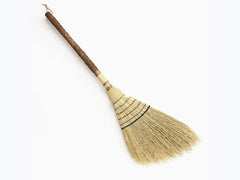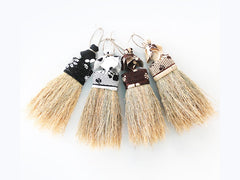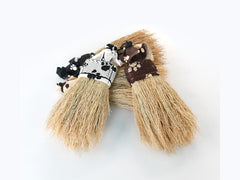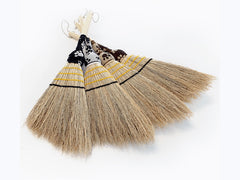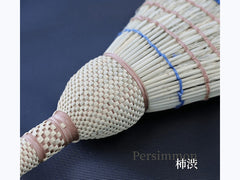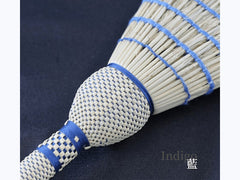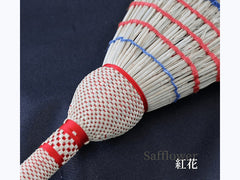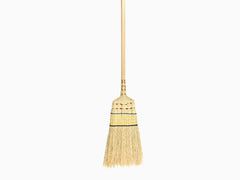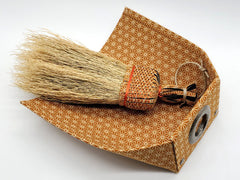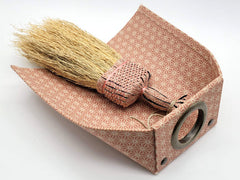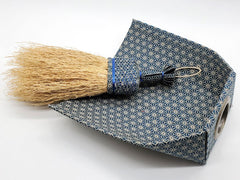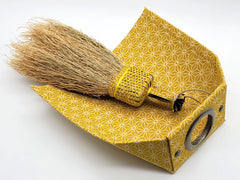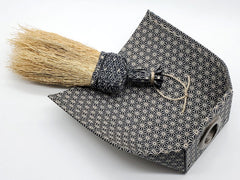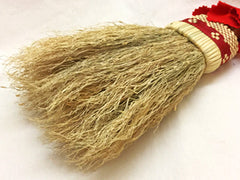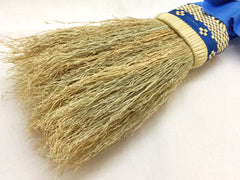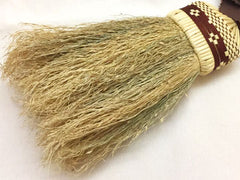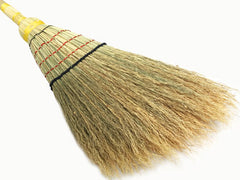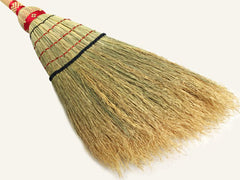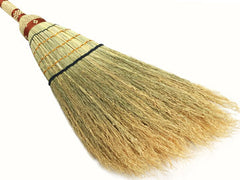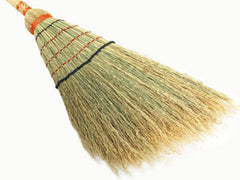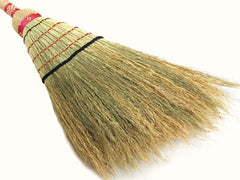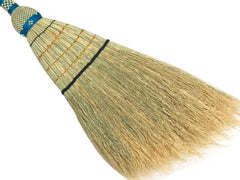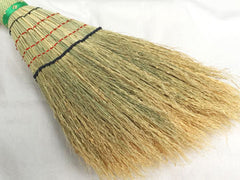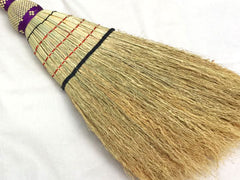Pikaichi Broom can remove dirt that even a vacuum cleaner can't!
This broom is a Pikaichi broom, with its uniquely curled bristles that catch and sweep away debris!
It can also effectively catch pet hair, human hair, and dust tangled in carpets.
Producer Takakura grows broom grass without the use of pesticides and handcrafts his brooms. Domestically grown
broom grass is extremely rare these days, and the broom grass that has endured Iwate's harsh natural environment is particularly resilient and durable, meaning it can be used for many years to come.
Experience the power of this carpet-friendly broom, designed with the user's health and the natural environment in mind.

We make everything by hand, from growing the broom grass!
Producer Takakura grows broom grass without the use of pesticides and then makes the brooms by hand.
Domestically grown broom grass is now very rare, and the brooms made from its unique curled tips are Pikaichi brooms, which sweep away dirt by catching it.
What is a Nanbu broom?
The Kunohe region in northern Iwate Prefecture was once called "Nambu." Farmers in this region have traditionally made and used their own tools. This work was carried out during the farming off-season, and was part of daily life during the harsh winter. Brooms, however, were made everywhere, and were a common sight. Anything not used by the farmers themselves was sold at markets and purchased by neighboring towns and villages, providing a secondary source of income for the farmers. This technique became the basis for the Nambu broom, and with Takakura's improvements and new techniques added, it has become the Nambu broom we know today.
Broom grass has endured harsh winds and snow, making it strong and durable!
"Iwate is cold, so the cultivation period is longer than in warmer places. This allows the broom grass to mature, become stronger, and become more durable. You can tell the difference as soon as you try sweeping," says producer Takakura.
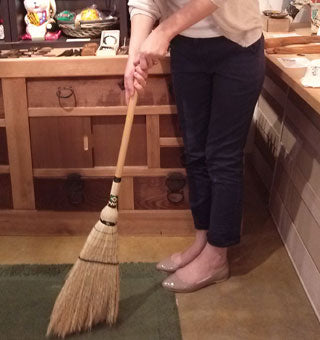
The Takumi no Hako staff also tried cleaning it!
Compared to a regular broom, it picks up dust much better!
Regular brooms have a rough feeling when you sweep, but Takakura's broom sweeps very smoothly.
It catches dust that a vacuum cleaner can't pick up, as if it's entangled.
"The less force you use, the better the dust is picked up. It's comparable to brand-name vacuum cleaners!" (Takakura)
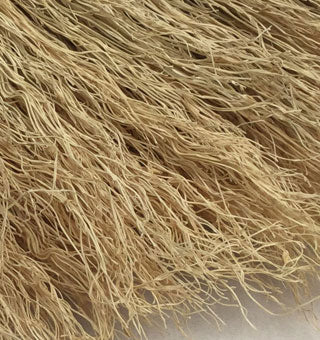
Made from pesticide-free broom grass!
Producer Takakura grows the broom grass without the use of pesticides, with the health of users and the preservation of the natural environment in mind, so you can use it with confidence.
The strong "curly" tip of the broom is the secret to Pikaichi's broom!
The strong, curly bristles are a distinctive feature of the Nanbu broom. These curls allow it to clean not only tatami mats and hardwood floors, but also lint, hair, pet hair, and even cigarette ash that have become tangled in carpets and rugs.
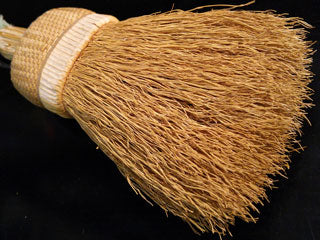
Look at the shine on this broom that's been used for over 25 years!
The broom in this photo has been used for over 25 years.
It has developed a beautiful amber color and even a glossy finish.
Many of Takakura's customers have been using his brooms for over 20 years.
How Takakura's broom is made.
The making of Nanbu brooms begins with soil preparation. The soil of the fertile 1.5 hectares cultivated is thoroughly turned over, and broom grass stalks from the previous year's harvest are added as compost. Then, seeds are sown one by one, trampled on, and covered with soil.
The harvest finally arrives after the Obon festival. The grass grows to about three meters, and is cut by hand when it is still green and has not yet turned color and drooped. It takes a month and a half to harvest the entire broom. The grass is then boiled and sun-dried... and before it is braided, veteran artisans carefully select the grass by hand and with their eyes. The selected broom grass tips are bundled together and patterns are woven using silk thread to complete the braid.
(1) Soil preparation and harvesting
In the spring, once the snow melts, soil preparation for making brooms finally begins. Once the soil is prepared, the next step is sowing seeds. This is done over an area of approximately 1.5 hectares (the equivalent of 1.5 Tokyo Domes) from late May to early June. After composting the broom grass stalks harvested the previous year, the seeds are sown one by one, trampled on, and then covered with soil. Everyone works together to harvest each stalk by hand. At this time, any that cannot be used for products are carefully sorted out.
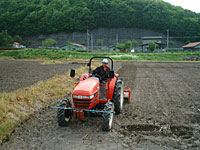
(2) Sorting, threshing, boiling
After the broom grass is harvested, the heads are aligned before threshing. Once the heads are aligned, the broom grass can finally be threshed. Once threshing is complete, the broom grass is thoroughly dried, but before drying it is boiled in water to give it a nice color. Here, the broom grass is boiled in a boiling kettle all at once.
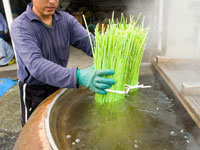
(3) Drying and sorting
After boiling, the broom grass is dried in the sun within six days. If this is not done, it will grow mold and will not be usable as a product. The weather, of course, and the temperature and humidity are of paramount importance.
Once drying is complete, it takes about a month for about five people to sort the grass into 15 stages. For the highest quality products, the materials are further scrutinized.
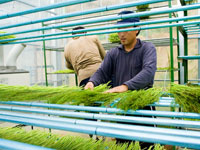
(4) Lace-up
Using selected materials and silk thread, each broom grass is woven one by one. The process of bundling the tips of the broom grass and weaving them into a single broom is physically demanding. Patterns are woven into the silk thread to complete the broom. The
highest quality products use custom-made gold thread. The weaving stitches are very small, making it a difficult technique.
There are over 60 different items, including long-handled brooms, one-handed brooms, Tomoe brooms, and mini brooms that are convenient for brushing Japanese clothing and computer keyboards. Some of the highest quality products take more than three years to complete.
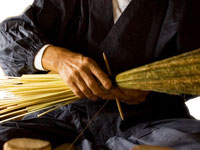
How to use
Nanbu brooms use their unique curled bristles to sweep up dirt.
These curls cleanly sweep away lint, hair, pet hair, and even cigarette ash that has become tangled in rugs and carpets, as well as tatami mats and hardwood floors.
Depending on how you use it, a Nanbu broom can be used for decades. It's a little different from a regular broom, and one of the keys to long-lasting use is to take good care of the bristles.
The trick to sweeping is to sweep gently, following the grain of the material, such as tatami or fabric. When sweeping, you can sweep lightly by moving the bristles gently without applying force. Sweeping rhythmically at a steady rhythm will result in good results.

(1) Nanbu brooms can last for decades depending on how they are used.

(2) If you use the broom only in the same direction, it will become bent, so try to use it in both directions as much as possible.

(3) Avoid pressing too hard and bending the tip as this will damage the tip.

(4) Never hit the broom with the corner of an object to remove dirt from it. This also applies to bedding.

(5) When not in use, hang it up or stand it up with the tip facing up.
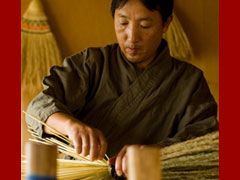
A word from the craftsman
Please try out the Nanbu Broom, which has been painstakingly crafted from the broom grass growing process. Try sweeping and you'll immediately see the difference!
